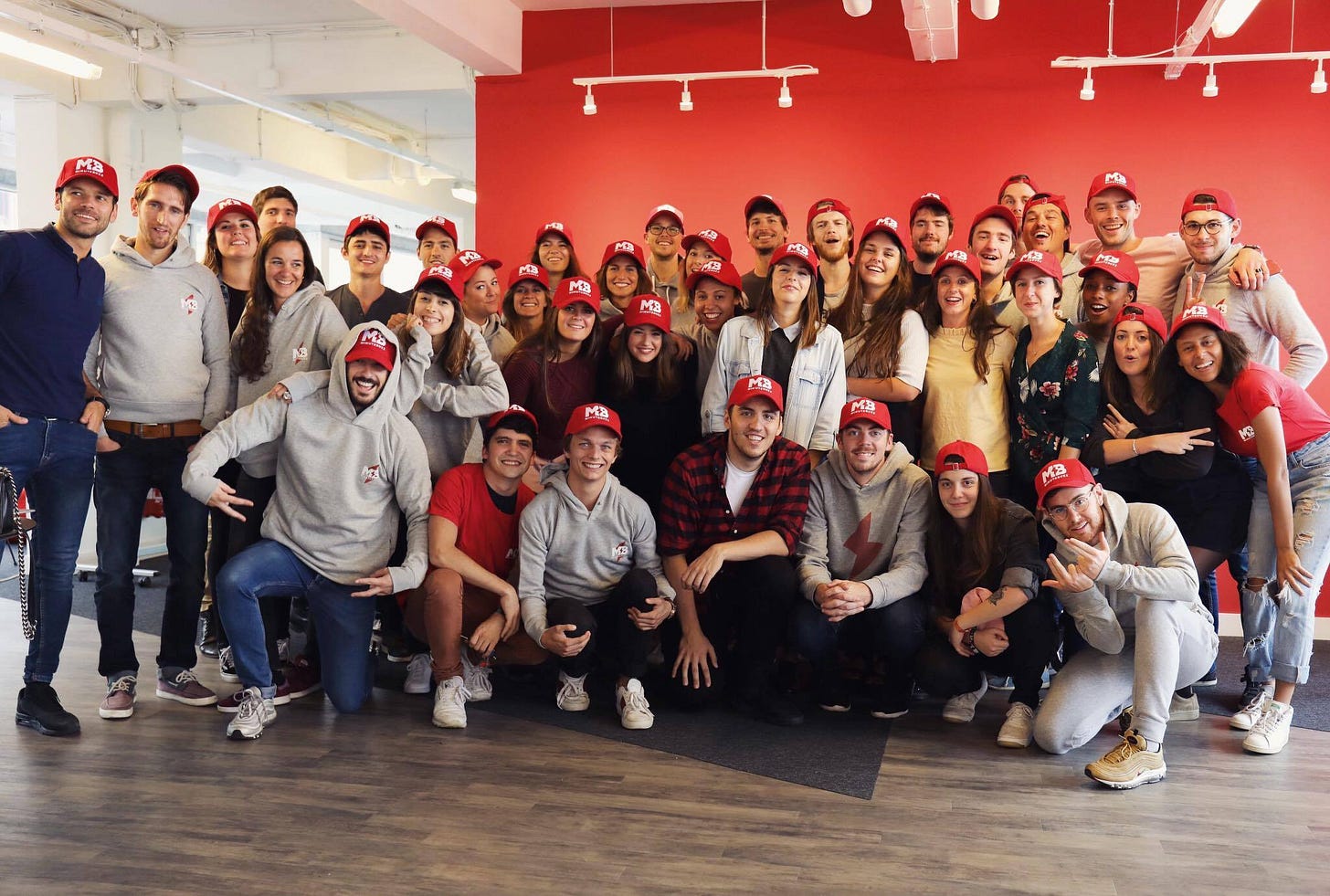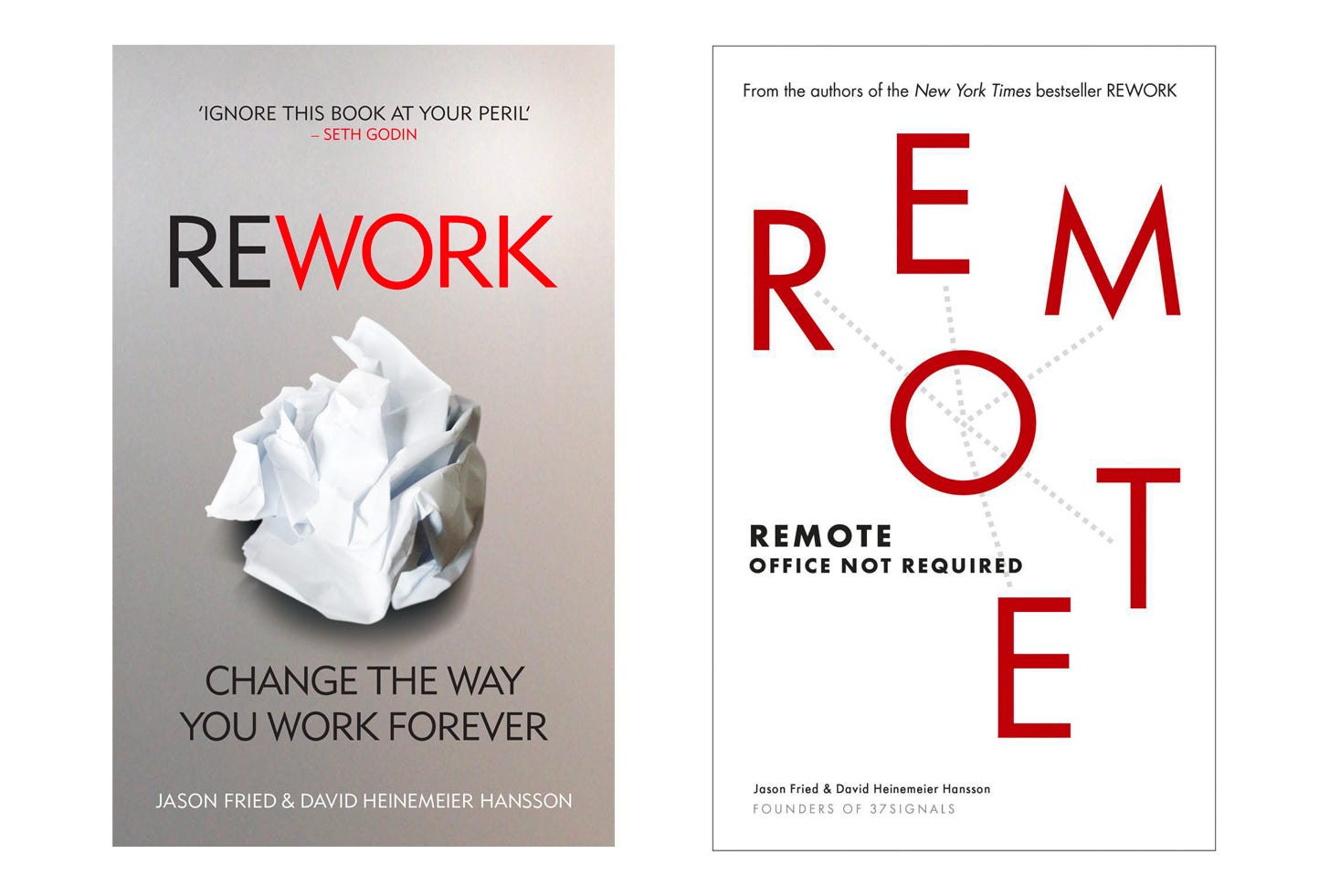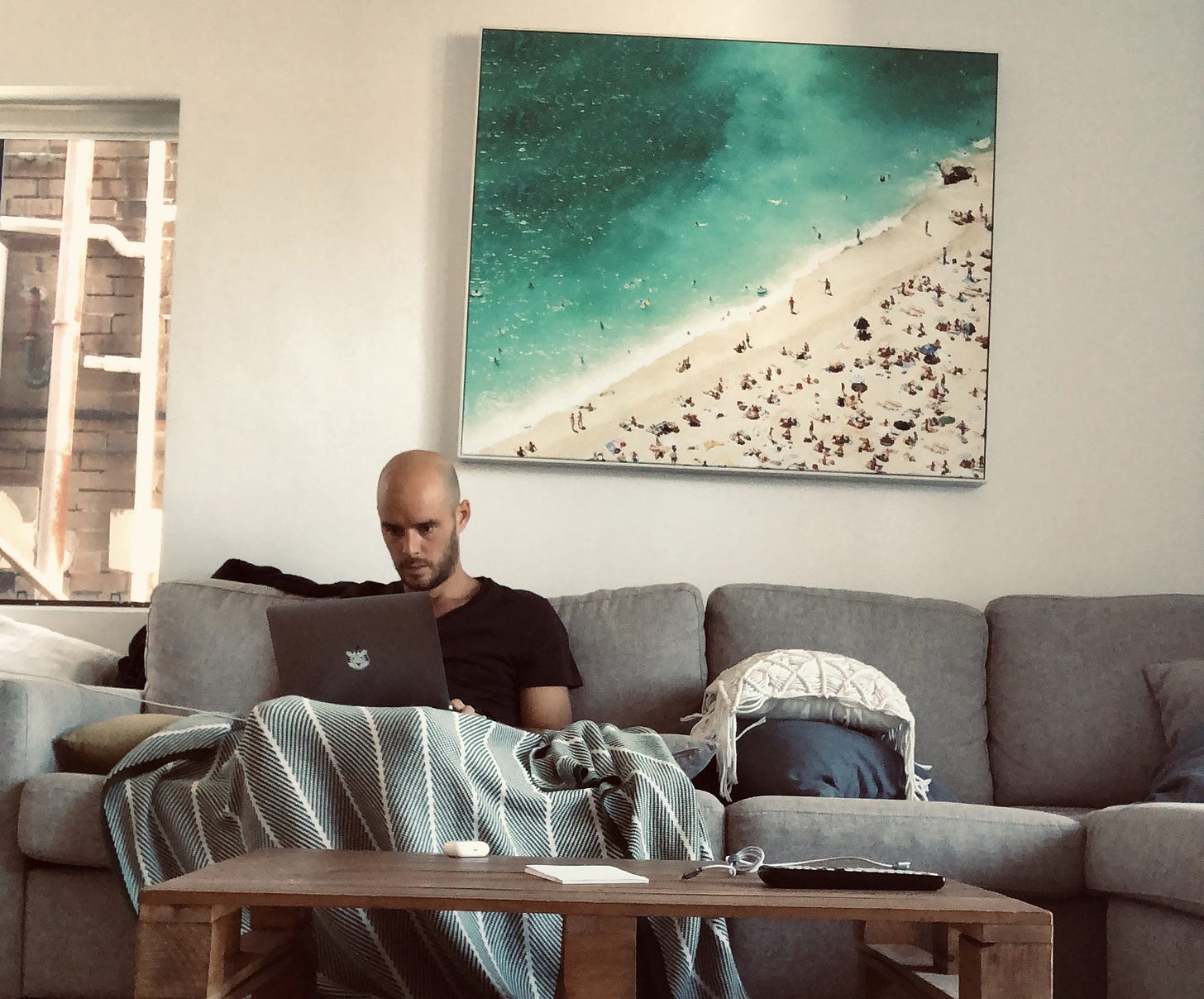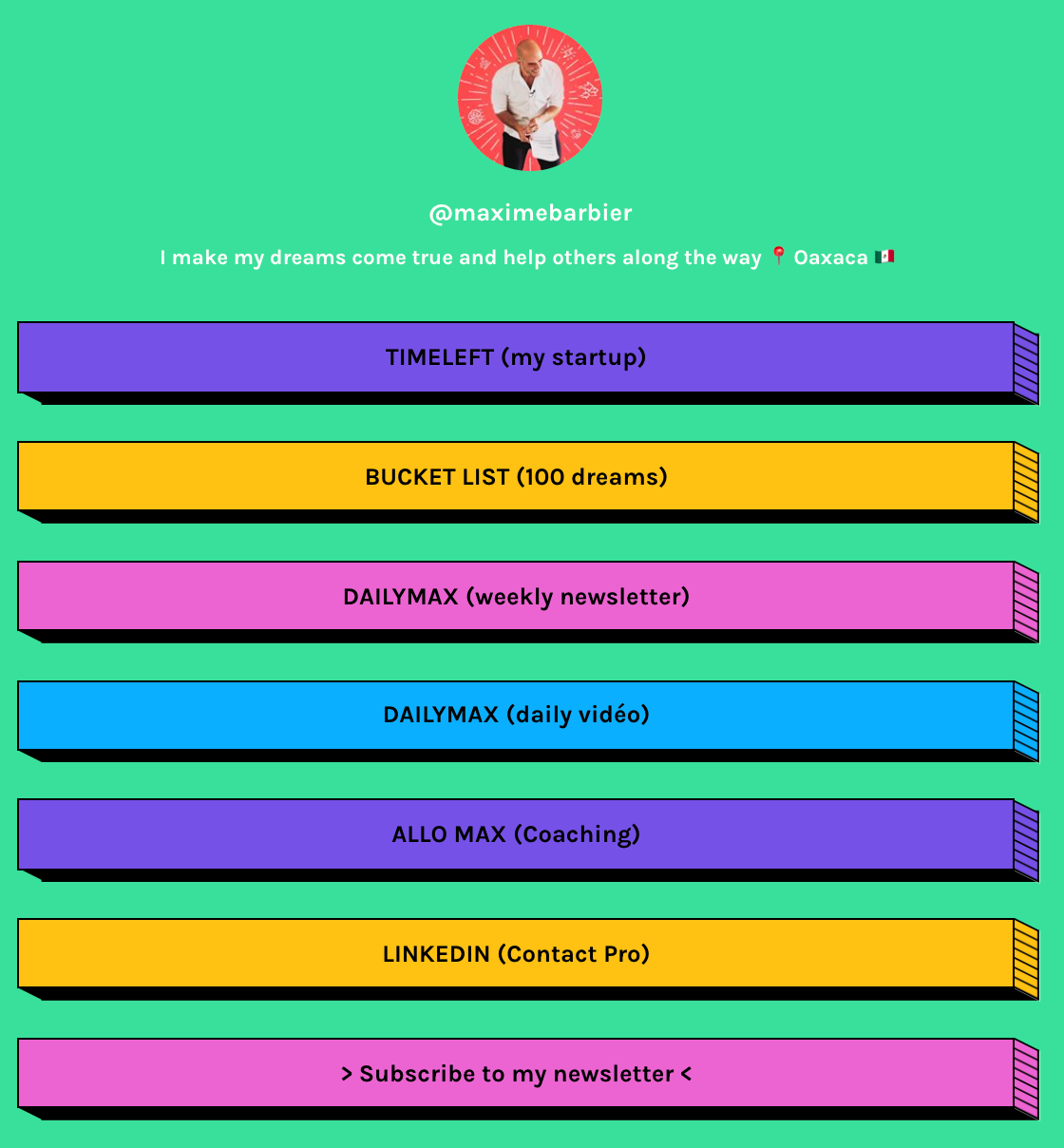Since I left MinuteBuzz and its 85 employees, my vision of “what I want as a startup” has evolved! Three years ago, I didn’t want to hear about “remote” and my greatest pride was in our 1500m2 offices and video studios.
Yes, I admit it now, I was the perfect cliché of the “successful” young Parisian entrepreneur. Looking back, despite the ups and downs, that 10-year chapter is still the best thing that ever happened to me! But this new Timeleft chapter looks to be even more exciting.

Everything went much faster than expected
After my eventful 5-day layoff by our majority shareholder TF1 on October 15, 2019, I’m getting my foot back in the door just 6 months later with the first version of Timeleft.com going live on April 22, 2020.
A few months later, Adrien De Oliveira, in charge of inbound marketing at MinuteBuzz, joined me to create the company together in September 2020. It was only 10 months later, in the summer of 2021, that things accelerated. We managed to convince a CTO and investors to join the adventure and little by little, a team of freelancers (we are hiring! click on the logo below!) was created around us to meet our strategic needs.

During my time in Mexico (and its 7 hour time difference), we quickly realised that having a “Full-Remote” company was going to be both exciting and challenging. Having worked together for 3 years in the same start-up, we quickly agreed on what we wanted and what we didn’t want anymore.
Here are some examples:
- “Having the company logo painted in huge letters on the front wall” has become “Being able to go surfing between 2pm and 4pm if the waves are there”.
- “Having everyone in the office by 9.30am at the latest” has become “Coming from all over the world to meet once a month in the same city”.
- “Recruiting as many employees as possible (to look good at Parisian dinners)” has become “staying a small, agile, mobile and ultra-efficient team”.
- “Having a business model that depends on a commercial strike force (based in Paris)” has become “Having an international scalable tech platform with an automated business model”.
It’s good to know “what you want” but then you have to make it “happen”. As with all my challenges, I started with the theory. In other words, I read (or saw or listened to) everything I could on the subject and talked to the “state of the art” (those who have succeeded in what I am trying to achieve).
Today I’m going to tell you about two reference books on the subject (if you have others, I’m interested!) I just finished the books “Remote Office Not Required” + “Rework Change the Way You Work Forever”, both by the same author, David Heinemeier Hansson, creator of Ruby On Rails and co-founder of Basecamp and Hey.com

Timeleft : a full-remote startup
If you don’t know yet what I do for a living, you should know that I’ve been an entrepreneur for 18 years (half my life!). After having founded VerticalStation (formerly MinuteBuzz), the largest French media group on social platforms (+18 million subscribers / +2 billion video views per year), I’m back in business with our new startup Timeleft.
Our vision? We imagine a world where everyone wakes up inspired to live their dreams. After 12 months of iteration, we’ve come up with our plan of action: to connect members who have the same dreams, so that together, they can help each other to achieve them.
The first tests were so successful that we have decided to pivot completely with the complete redesign of our platform which will be released at the end of the month. In addition to this strategic choice, we will go 100% mobile and launch directly in the United States.

The best part of all this? We convinced 4 prestigious investment funds (and 10 business angels) to join the adventure!
Only fools don’t change their minds (French proverb)
Let’s get right down to business! Here are the 17 main elements I retained from my theoretical phase, the ones that really convinced me that the world of work today is already in full-remote.
I am of course open to feedback and advice (write to me here), as this is only the beginning of our adventure, and we will surely make mistakes.
“those who think it is impossible are please not to disturb those who are trying”
1/ Work does not take place at work
We’ve probably all experienced it once in our careers, that moment when we felt obliged to come very early or stay very late at the office to FINALLY concentrate and not be disturbed every 15 minutes.
Since the advent of open spaces, offices have become the least efficient places to be focused. We are constantly disturbed by a colleague who needs an immediate answer to move forward, and unfortunately we often do the same thing. We barely have time to concentrate before we have to go back to the meeting. At the end of the day, we wonder where our time went…
2/ Stop unnecessary commuting
I’ve always been lucky enough to have my offices close to my home and to have the most practical means of transport in Paris: an MP3 500 scooter. So I couldn’t complain about my 2x15min daily commute. On the other hand, the vast majority of employees are forced to commute 60 to 120 minutes just to start work. In addition to the time lost, add to the daily impact of the negative energy that floods Parisian public transport.
As the author says: 1.5 hours a day is 7.5 hours a week. That’s about 300-400 hours a year. That’s just enough time to learn to code, draw or get fit.
The new luxury is the luxury of freedom and time. Once you’ve had a taste of that life, no corner office or fancy chef will be able to drag you back.
3/ Switching from “Synchronous” to “Asynchronous” mode
With the amazing tools at our disposal like Trello or Notion, we don’t need to be in the same place to work together, but more importantly, we don’t need to work at the same time to work together.
So whether you work from 11am to 7pm or 7am to 3pm, it’s all the same. The advantage of flexible working hours is that they are suitable for everyone, from early risers to late sleepers and families whose children need to be picked up in the middle of the day.
Ideally, you should try to maintain a certain amount of time per week (40, 45 or 55 hours, it’s up to you) but it doesn’t matter how you divide your time between hours and days.

4/ The end of the big city dictatorship
We all know the expression “go to the capital to find a job”. This was true 15 years ago, but it is no longer the case. The real luxury of the next twenty years will be to leave the “Capital” (or the big cities) to move much further away (yes, further than the inner suburbs).
On the other hand, it will put an end to the competitiveness between “neighbours”. When dozens, even hundreds, of competitors are within walking distance of your company, it is not surprising that employees will cross the street and join the next hot company. This phenomenon is very present in Paris in the very closed eco-system of digital start-ups.
5/ Being “grey” rather than “white or black
Adopting remote working doesn’t mean you can’t have offices, it just means you don’t have to. It doesn’t mean that all your employees can’t live in the same city, it just means they don’t have to. Remote working is about giving your team the freedom to do their best work wherever they are.
6/ You are probably already working remote
How many times a day do we send emails or notifications to a colleague sitting 10 metres away from us? If you look closely, we often go to the office to work “remotely”. At the end of the day, was it really worth coming to the office for that?

7/ The magic only happens in the meeting rooms
I thought so until the idea of Timeleft was born, with me sitting quietly on the sofa in my Sydney flat (see picture) and my partner sitting on his Parisian sofa.
We only saw each other “physically” 5 months after the official launch of the platform. In short, you’d be surprised how much quality groupthink can be captured with two simple tools: a voice connection and a shared screen
I have no desire to go through an entrepreneurial adventure without ever seeing my employees, but I am now convinced that face-to-face meetings should be “rarefied”. This makes them more important and more effective. See the next point.
8/ Easy on the M&M’s (Meeting & Management)
Every time I hear the phrase “sorry today, I have meeting back-to-back”, I can’t help but feel compassion. If you have back-to-back meetings, when can you take time for yourself, to move forward on “your” things? By the way, do you know anyone who wishes they had more meetings? I don’t think there are any.
And why is that? Because meetings have become an “overused” commodity, that they have lost all their reasons for being. When MinuteBuzz joined the TF1 group, I attended legendary meetings, where some people had no business being there (they knew it, we knew it) but they were invited anyway so they worked on other subjects (or even prepared other meetings). Or worse, meetings that ended with the organisation of… another meeting!
Too many meetings can destroy morale and motivation. Especially when they are (as is often the case) organised at the last minute without a clear agenda.
In remote locations, meetings still have their place, but it is important to take advantage of the distance to put as much as possible in writing (therefore more synthetic) and asynchronously. Speaking of writing, to be a good remote collaborator, it is essential to be a good writer. When most discussions are settled by email, Trello notifications or slack conversation, you had better show up equipped for the task. We all know how much a situation can escalate in writing.

9/ The One-on-Ones
Towards the end of my leadership experience at MinuteBuzz, I got into the habit of doing short 30-minute one-on-ones with all my managers, all on a weekly basis. But rather than a sterile face-to-face meeting in a meeting room, we go out into the field together to try to solve a concrete problem. This allowed me to stay in touch with reality and to build up their skills.
I think it is key to keep this gymnastics in a full-remote organisation. This can take the form of a video-call with a shared screen or simply a telephone exchange on a specific subject. I think the ideal is around once every 5 to 10 days per employee. The aim is to maintain an open and coherent line of communication. These quick calls prevent problems and concerns from accumulating without being addressed. Morale and motivation are fragile things, so you need to make sure you keep your staff’s pulse on the line.
Waiting six months or worse, waiting for the end of year assessment (which I have never managed to ban at MinuteBuzz!) is far too long. The longer you wait between appointments, the more your vision widens and you no longer see the small details that often cause problems.
The beauty of it all is that even if someone is thousands of miles away, everyone knows how to make a phone call (or a whatsapp / telegram). Just chat, nothing more, and see what happens. You’ll be surprised how much you’ll discover on your first “date”.
10/ If I can’t see them, how do I know they are working?
This 10th point hurts, because it is so true. I can still see myself at the end of 2019, answering the same question at the “all-hands meeting” at the beginning of each month, where my 80+ employees asked the question of teleworking in unison. It hurts, because I realise that this fear is only linked to a lack of trust, both in my teams and in my leadership.
Let’s face it, if your employees want to spend their days watching videos, they can do so at home as well as in the office (in front of your eyes). In other words, if you’re not comfortable letting your employees telework, the basic problem is probably one of trust.
11/ What are the acceptable timezones?
We can agree together that a “normal” working day is around 9am-6pm. We can also agree that an employee’s availability of 3 hours a day (i.e. 1/3 of the day) to meet collective needs (meetings or workshops) is sufficient. So it can come down to a simple rule: “you can work from anywhere in the world as long as you are available for at least 3 hours between 9am and 6pm (Paris Time)”.
If I take the example of my house in Oaxaca (Mexico) and its 7-hour time difference, I would simply have to be in front of my computer at 8am at the latest. And if I decide to move to Los Angeles, then I would have to be at my computer at 6am. And in the late afternoon if I decide to spend a month in Tokyo.
On the other hand, I think it is essential to set up a three-day mini-seminar once a month to create a link. You can imagine paying for the plane ticket for 200 or 300 euros. And if the employee is on the other side of the world, he will only have to pay the difference in price.
12/ Information for all
It is obvious that a full-remote business requires a certain amount of rigour. For example, it is impossible to lock up important information in one person’s computer or inbox. You have to make everything that is important available to everyone, so that one person is not stuck for several days because Roger has gone on a roadtrip to Alaska.
Rest assured, these days there are all the tools you need to make this as easy as pie. From Dropbox to Notions to Google’s shared calendars, you’ve got everything you need to get everyone working properly and stress-free
When you and your colleagues are sitting in the same place, it is easy to think that you are aware of what is going on in the company. You stop and chat with your office mates while making coffee in the morning, and over lunch you discuss the latest developments. There is a constant, even unspoken, flow of information through the office. At least that’s how it feels, and it’s a comforting feeling.
Hence the importance of re-creating this digitally. This can be done with tools such as KnowYourTeam and Basecamp or simply with rituals such as a weekly hangout where everyone presents their progress from the past week.
13/ Removing obstacles
This is one of the biggest challenges. My partner and I are currently working on this and we have decided to keep “only” two tools: Notions + Slack. After having tried Workplace + Trello + Whatsapp.
Removing barriers means allowing everyone to work when they want to, on the topics they need to, without being limited by the availability of an employee. So you need to make sure that people have access, by default, to everything they need. Most companies start with the opposite policy: everyone has access to information and applications only on a “need-to-know” basis. This is totally unnecessary.
It starts by empowering people to make decisions for themselves. If the company is made up of people who no one trusts to make decisions without going through levels of management control, then the company will be its own limiting factor.
And yes, a good part of the problem is managers’ pride (I plead guilty) in being Mr or Mrs Roadblocks. We all know that being sought after, even courted, gives a certain perverse satisfaction. Don’t ignore the power of this syndrome.
You won’t believe how many tools are now available to help you (as a manager) to let go in any situation, such as Swile or Qonto.
Of course, freedom and trust are things that can quickly be damaged. But it is better to try to solve problems at the grassroots level, rather than fall into the path of dictatorship. If you let them, humans have the power to live up to your expectations of rationality and responsibility.

14/ Check-in, Check-out
We think that the danger of remote is sloppiness, when in reality it is the burnout. I talked about this discreetly a year ago in DailyMax #081
It’s easy to get sucked into the urge to work all the time. It starts innocently enough. You wake up by opening your laptop in bed and answering some work emails from last night. Then you make yourself a sandwich and work through lunch. After dinner you feel the need to contact Hughes on the West Coast to talk to him about something. Before you know it, you have stretched your working day from 7am to 9pm.
It is therefore crucial to succeed in setting limits, either during the day (e.g. not working after 7 p.m.) or during the week (e.g. giving yourself a day off after working 40 hours).
If yesterday was a good day at work, chances are you’ll stay on track. And if you can keep the momentum going, everything else will probably take care of itself, including not working from dawn to dusk.
Likewise, working from home gives you the freedom to work wherever you want. You can start on the kitchen counter, continue on the sofa and, if the weather is good and you have a garden, finish outside enjoying the sun. But if you really want to work from home in the long term, you need to respect the basic principles of ergonomics. This means having a nice, dedicated workspace with all the comfort and quiet you need. If you don’t have the space or the opportunity, look into co-working spaces. There are more and more of them!
Ps: also think about moving around, such as taking a short daily walk after breakfast or doing a sports session at the end of the day. Don’t restrict your movement inside your home.
15/ Human above all
Hiring people remotely can carry the risk of “restricting” their lives. When you travel to work or the company has a cafeteria or gym, it is easy to meet new people and see the sights. This is less obvious if you don’t have to leave your home.
It is advisable to make sure that you help your employee to work on diversity and personal development, either by encouraging hobbies or other bucket lists, or by organising events where the whole company can get together (e.g. a seminar in the mountains). This is a small price to pay for an interesting environment and for keeping people engaged in the long term.
Another example: it may be appropriate to organise “physical” sprints if the company has to race to meet a deadline, with the unreasonable hours and pressure that this entails. It will always be more enjoyable to go through this together.
Just because you work remotely most of the time doesn’t mean you have to, or should, work remotely all the time.
16/ Make a first try before saying yes
This is a practice I have implemented with Timeleft: to do a paid test with the person you want to hire or associate. You can’t judge a person on his or her CV, and even less so with a single interview. On the other hand, after 1 or 2 weeks of working on a common project, you can have a small idea of the good (or bad) “feat” with the person. In short, you can see this as a “paid pre-employment”.
You can even go a step further by arranging a ‘live’ meeting. Even if the candidate will be working remotely, it is a good idea to meet them in person before making the final hiring decision. This will give you an idea of their character. Are they polite? Do they arrive on time? Are they basically decent? Do they treat people well? What does the rest of the team think? A quick face-to-face meeting can tell you a lot.
17/ Have routines
It’s tempting to spend the day in your pyjama trousers (as you can only see the top during video-calls). They’re probably very comfortable, but they may not be the state of mind you need to get through the day.
Just as it is beneficial to create a separation between your work space and your living space, it can also be useful to separate the clothes you wear, depending on whether you are in work or leisure mode.
You are also free to juggle working at home and working in the office (or in a co-working space). Some days can be spent in the office, and others outside the office. But you can go even further. Days don’t have to be all or nothing either. You can split the day in two and work remotely in the morning and in the office in the afternoon.
In short, flexibility should be your friend, not your enemy. Being remote is not binary, I even think it’s being hybrid. And having done it for 2 years, it is quite possible to be “hyper-nomad” (changing cities every month). It just requires military organisation like making sure you have good WIFI if you have to make important calls or finding quiet places for deep-work sessions

Wanna join the adventure ?
For the past year, we have been working on the same goal: to help as many people as possible to wake up and live their dreams.
The global pandemic we just went through made us realize that life is short and what was really important to us. At Timeleft, we felt a global and sustainable need for change in people’s lives.
We have already received thousands of dreams from all over the world, showing how many people have dreams inside them, like finding a meaningful job, travel across a country on horseback or simply learning how to draw. People are not only looking forward to make those dreams come true, they also want someone to share their dreams with.
To successfully fulfill this mission, we are looking to strengthen our team and this is where you come in!
Timeleft is a startup backed by top tier consumer and tech VCs (Paris / New York / Lisbon). All our positions are remote, with the possibility to co-work with our teams distributed in Paris, Lisbon or Los Angeles.
We all meet every month for 3 days in the beautiful city of Lisbon, to have a real time experience of brainstorm and working together.















 Live with me this summer in Mexico in my nomad house
Live with me this summer in Mexico in my nomad house